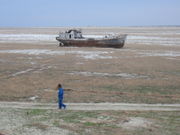Drought
2008/9 Schools Wikipedia Selection. Related subjects: Climate and the Weather
A drought is an extended period of months or years when a region notes a deficiency in its water supply. Generally, this occurs when a region receives consistently below average precipitation. However, it can also be worsened by man. It can have a substantial impact on the ecosystem and agriculture of the affected region. Although droughts can be long-lived, even a short, intense drought can cause significant damage .
Man-made erosion can play a role, as it did in the North American Dust Bowl in the 1930s, as can general climate change. Many speculate that global warming will have a substantial impact on agriculture throughout the world, and especially in developing nations. For most regions, drought is a normal, recurrent feature of the climate, and having adequate drought mitigation strategies in place can greatly reduce the impact. Regardless of the cause, recurring drought can also bring about desertification. Recurring droughts in the Horn of Africa have created grave ecological catastrophes, prompting massive food shortages, still recurring.
Consequences
Periods of drought can have significant environmental, economic and social consequences. The most common consequences include:
- Death of livestock.
- Reduced crop yields.
- Wildfires, such as Australian bushfires, are more common during times of drought.
- Shortages of water for industrial users.
- Desertification
- Dust storms
- Malnutrition, dehydration and related diseases.
- Famine due to lack of water for irrigation.
- Social unrest.
- Mass migration, resulting in internal displacement and international refugees.
- War over natural resources, including water and food.
The effect varies according to vulnerability. For example, subsistence farmers are more likely to migrate during drought because they do not have alternative food sources. Areas with populations that depend on subsistence farming as a major food source are more vulnerable to drought-triggered famine. Drought is rarely if ever the sole cause of famine; socio-political factors such as extreme widespread poverty play a major role. Drought can also reduce water quality, because lower water flows reduce dilution of pollutants and increase contamination of remaining water sources.
Stages of drought

As a drought persists, the conditions surrounding it gradually worsen and its impact on the local population gradually increases. Droughts go through three stages before their ultimate cessation :
- Meteorological drought is brought about when there is a prolonged period with less than average precipitation. Meteorological drought usually precedes the other kinds of drought.
- Agricultural droughts are droughts that affect crop production or the ecology of the range. This condition can also arise independently from any change in precipitation levels when soil conditions and erosion triggered by poorly planned agricultural endeavors cause a shortfall in water available to the crops. However, in a traditional drought, it is caused by an extended period of below average precipitation.
- Hydrological drought is brought about when the water reserves available in sources such as aquifers, lakes and reservoirs falls below the statistical average. Like an agricultural drought, this can be triggered by more than just a loss of rainfall. For instance, Kazakhstan was recently awarded a large amount of money by the World Bank to restore water that had been diverted to other nations from the Aral Sea under Soviet rule . Similar circumstances also place their largest lake, Balkhash, at risk of completely drying out .
Drought mitigation strategies
- Desalination of sea water for irrigation or consumption.
- Drought monitoring - Continuous observation of rainfall levels and comparisons with current usage levels can help prevent man-made drought. For instance, analysis of water usage in Yemen has revealed that their water table (underground water level) is put at grave risk by over-use to fertilize their Khat crop. Careful monitoring of moisture levels can also help predict increased risk for wildfires, using such metrics as the Keetch-Byram Drought Index
- Land use - Carefully planned crop rotation can help to minimize erosion and allow farmers to plant less water-dependant crops in drier years.
- Rainwater harvesting - Collection and storage of rainwater from roofs or other suitable catchments.
- Recycled water - Former wastewater (sewage) that has been treated and purified for reuse.
- Transvasement - Building canals or redirecting rivers as massive attempts at irrigation in drought-prone areas.
- Water restrictions - Water use may be regulated (particularly outdoors). This may involve regulating the use of sprinklers, hoses or buckets on outdoor plants, the washing of motor vehicles or other outdoor hard surfaces (including roofs and paths), topping up of swimming pools, and also the fitting of water conservation devices inside the home (including shower heads, taps and dual flush toilets).
